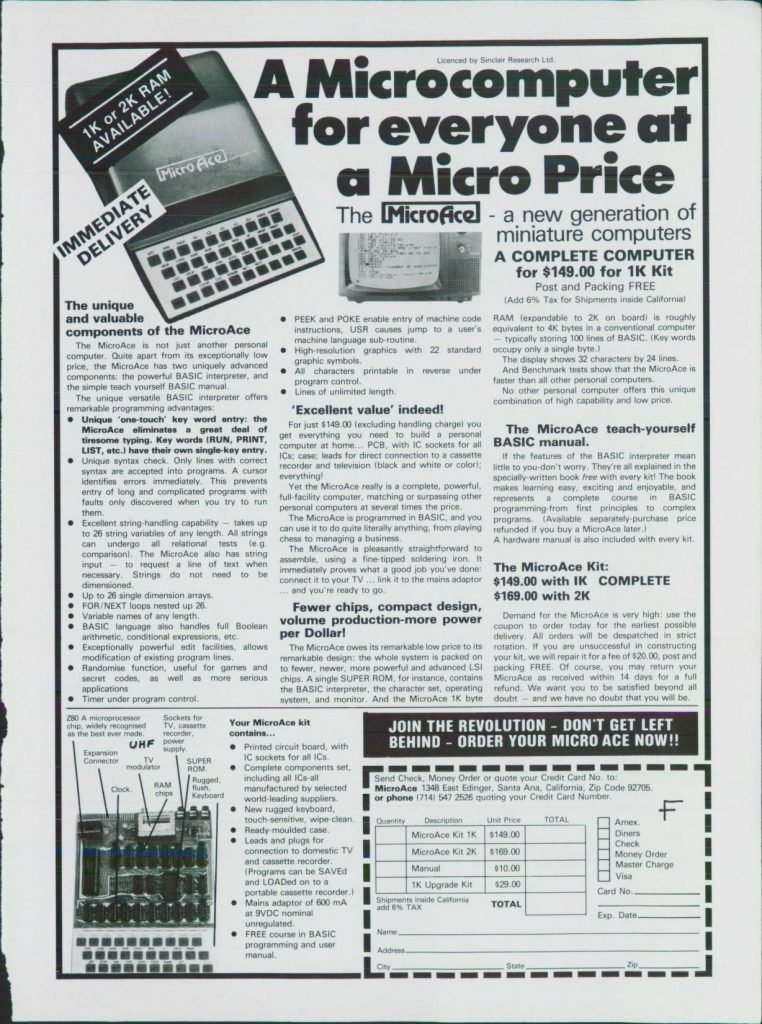MicroAce produced a kit that was a clone that was a visual negative of the ZX80. Where the ZX80 case was white, the MicroAce was black. And the ZX80 had white lettering on blue keys, the MicroAce had black letters on red keys.
As it turned out, MicroAce’s kit wasn’t an authorized copy and Sinclair sued the company that produced it. The settlement allowed MicroAce to market their product with certain restrictions.
Alfred Milgram: How is MicroAce distributing their product here? I don’t see them in the magazines, they are not visible.
David Ahl: Strictly by mail order. They have been restricted by Sinclair from advertising in a certain group of publications that Sinclair has reserved for itself. Sinclair has more or less picked the top one or two magazines in each individual field and left the balance to MicroAce which is a policy, in my mind, to defeat MicroAce. What is the story on that? What actually happened between Sinclair and MicroAce?
Milgram: The people at CompShop have a history of copying. The guy behind MicroAce is the guy who runs CompShop in the U.K. At one stage they couldn’t get enough supplies from Ohio Scientific, so they redesigned the OSI Superboard and got the ROM from Microsoft. Now they are paying the royalties to Microsoft, have redesigned the board and are selling it as the U.K. 101.
Then the Sinclair came out and they figured here was a golden opportunity to save on development costs and come out with effectively the same machine. They copied the ROM byte for byte, moved the circuits about, cleaned it up a bit and moved the RAM memory away from the heat sink. The case is black instead of white, and they were going to market it in the U.K. for £50 as opposed to £70, the price of the ZX80. Sinclair got upset and sued them for breach of copyright. In the case two items were put up for breach of copyright: stealing the ROM and the keyboard. The judge said in effect. “I can’t read the ROM. Nobody can read the ROM. The ROM is not copyrightable. But the keyboard: that’s the same keyboard, anyone can see that.” They settled out of court.
Ahl: So Sinclair then licensed them to do a kit version?
Milgram: They allowed them, because at that stage they had gone quite a ways into manufacturing, and were already committed, with many thousand ROMs and printed circuit boards and all the rest of it. They couldn’t afford to pull out of it at that stage. So Sinclair allowed them to market it as long as they didn’t sell it in the U.K.. only sold it in kit form, and complied with the restrictions on advertising.
Ahl: From what I gather there are people at Sinclair that would like to design peripherals and add-ons that specifically would not fit the MicroAce.
Milgram: One of the reasons they told me that they were not prepared to let the new ROM out was that they did not want to be ripped-off in the same way. I don’t think they can really avoid it in the long run. Because basically anyone who has a MicroAce can go and buy a new ROM from Sinclair and pop it in.
Ahl: Will it fit?
Milgram: Yes. because it is a straight copy. The only thing that MicroAce has done is to add another 1K on board. Apart from that it is exactly the same machine. It has the same routines which all run in the same places, the same operating system, the same number of chips, it is basically the same machine. I can’t see how Sinclair can design anything that would not be compatible with the MicroAce.
